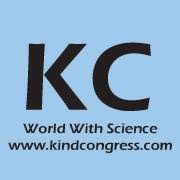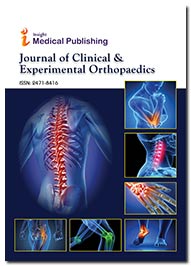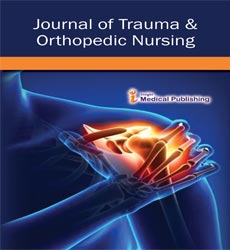Theme:
Orthopedics Summit 2020
Conferences Series LLC takes great pleasure in inviting the scientific community across the globe to the 15th Global Summit and Expo on Orthopaedics and Rheumatology Webinar scheduled during November 09-10, 2020 .
Theme of the Conference: "Retrospective and Contemporary aspects in Orthopaedics and Rheumatology”.
Orthopaedics Summit 2020 will put together world-class educators, scientists, physicians, students, researchers, doctors, pharmaceutical companies to explore techniques for Bone, Arthritis, Arthroplasty, Hip & Knee Replacement. The participants can exchange and share their research results covering the scientific aspects of Rheumatology, Osteoarthritis, Orthopaedic Surgery, Arthroplasty, Osteoporosis, Arthritis, Physical medicine and rehabilitation, Paediatric Orthopaedics, Joint replacement surgery, Spine Disorders / Spine Injuries, Musculoskeletal Disorders etc. The conference will encourage Young Researcher’s Forum, scientists and the researchers in their early stage of career graph to widely discuss their outcome so as to enrich and develop the idea.
15th Global Summit and Expo on Orthopaedics and Rheumatology will focus on many interesting scientific sessions and covers all frontier topics in orthopaedics which includes Orthopaedic Biological Research, Orthopaedic Clinical Research, Orthopaedic Biomechanics Research, Regenerative orthopaedics, Organ forming and 3D-printing, Shock wave therapy, Bone Biology and Pathophysiology, Cartilage Biology and Pathophysiology, Tendon Biology and Pathophysiology, Hip and Knee Arthroplasty and many more advanced topics in the field of orthopaedics and rheumatology. Research is the driving force, which needs to be translated towards advanced orthopaedic practice. Biomaterial, biomechanical and molecular science is successful though basics of trauma and joint replacement remain quite solid. Innovative implant coatings decreases infections and improve implant integration. Meniscus and tendon engineering, regenerative and reconstructive approaches, cellular therapies new hydrogels that allow controlled release of medicine and/or active signalling molecules into organs and tissues are advancing. Computer technology now can solve difficult problems using finite element analysis and rely on computational biomechanics. Tissue engineering is replacing most musculoskeletal tissues including peripheral nerves and skeletal muscles. The conference also includes Keynote speeches by prominent personalities from around the globe in addition to both oral and poster presentations.
Honored Distinguished Colleagues, Precious Academicians and Our Research Professionals,
A warm welcome to the Orthopaedics Summit 2020...!!
Do Mark your inordinate presence at 15th Global Summit and Expo on Orthopaedics and Rheumatology Webinar on November 09-10, 2020 .
15th Global Summit and Expo on Orthopaedics and Rheumatology will focus on many interesting scientific sessions and covers all frontier topics in orthopaedics which includes Orthopaedic Biological Research, Orthopaedic Clinical Research, Orthopaedic Biomechanics Research, Regenerative orthopaedics, Organ forming and 3D-printing, Shock wave therapy, Bone Biology and Pathophysiology, Cartilage Biology and Pathophysiology, Tendon Biology and Pathophysiology, Hip and Knee Arthroplasty and many more advanced topics in the field of orthopaedics and rheumatology. Research is the driving force, which needs to be translated towards advanced orthopaedic practice..
This conference is being organized in a beautiful, gaudy, cultural city of Amsterdam that has a history of several hundred years of welcoming people across the Globe.
The city magnetizes more than 26 million tourists worldwide every year. Geneva is a Global city, a financial center for organizing a conference which will add another glamor for social, cultural and touristic attraction while deliberating scientific presentation in a warm nice ambiance.
The conference would be focusing on Chemistry with the theme “Retrospective and Contemporary aspects in
Orthopaedics and Rheumatology”
We welcome you to Amsterdam and hope the current year's gathering will challenge and motivate you, and result in new learning, joint efforts, associations and some more...
Regards,
Organizing Committee Members
Orthopaedics Summit 2020
1.Orthopaedics:
Orthopedics is a medical specialty that focuses on the diagnosis, prevention, and treatment of patients with skeletal abnormalities, disorders of the bones, joints, muscles, ligaments, tendons, nerves and skin. Human body's musculoskeletal system is a complex system of bones, joints, ligaments, tendons, muscles and nerves and which allows you to move and work. Orthopedics now cares for patients of all ages, from new borns to young athletes requiring arthroscopic surgery, to older people with arthritis. The physicians who are expert in this area are called orthopedic surgeons or orthopedists. Orthopedist is a expert in the field of joint and bone problems. To the field of orthopedic surgeon includes: congenital anomalies of the musculoskeletal system, such as hip dysplasia, scoliosis (curvature of the spine); fractures of joints and bones (fractures); misalignments of joints and long bones; joint disorders (osteoarthritis).
2.Rheumatology: Rheumatology is a branch of medicine, which is dedicated to adequate diagnosis and therapy of rheumatic diseases. Branches of rheumatology involves basic research and clinical research, as well as clinical diagnosis, treatment, and long-term management of patients with these illnesses. Physicians who have undergone training in rheumatology are called rheumatologists. Rheumatologist is a expert in the field of nonsurgical treatment of rheumatic illnesses, including autoimmune diseases and especially the many forms of arthritis and joint disease. Rheumatology field is multidisciplinary in nature, which means it relies on close relationships with other medical specialties. Rheumatologists deal mainly with immune-mediated disorders of the musculoskeletal system, soft tissues, autoimmune diseases and heritable connective tissue disorders.
The department of rheumatology has undergone a numerous of striking advances in recent years, especially if we consider the development of biological drugs with novel targets, made possible by rapid improvements in the basic science of musculoskeletal diseases.
Subtracks:
- Autoimmune Disorders
- Rheumatic Fever
- Complications and Precautions
- Diagnosis and Treatment of Rheumatic Diseases
3.Arthritis: Arthritis is inflammation of one or more joints. The most common symptoms of arthritis are joint pain and stiffness, which typically worsen with age. The common types of arthritis are osteoarthritis and rheumatoid arthritis. The highly common form of arthritis is osteoarthritis. Other common rheumatic conditions related to arthritis comprises gout, fibromyalgia, and Rheumatoid arthritis (RA). According to the Centers for Disease Control and Prevention (CDC), 54.4 million adults in the United States have received a diagnosis of some form of arthritis. Of these, 23.7 million people have their activity reduced in some way by their condition. Arthritis is more common among adults aged 65 years or older, but it can affect people of all ages, including children.
Sub Tracks:
- Types of Arthritis
- Signs and Symptoms of Arthritis
- Epidemiology and Pathophysiology of Arthritis
- Diagnosis and Treatment of Arthritis
Athletic injuries, arthritis and accidents are common causes of damage to the bones, tendons and ligaments of the knee and hip. Injuries to these joints can have a huge impact on mobility and independence. Many chronic hip and knee problems do not require joint replacement but are painful enough to curb mobility and affect quality of life. If you have torn a ligament, meniscus or cartilage in your knee, surgeons can often evaluate and repair the problem in an arthroscopic procedure. Surgeons also use arthroscopy to view and rectify problems using the hip joint. These slightly invasive procedures can relieve pain and restore mobility and reduce post-procedure pain and require far less recovery time.
The knee joint is the major one in the body. It helps the leg to bend and straighten. The knee joint is located at the middle point of the thigh bone (femur) and the shin bone (tibia). During knee replacement surgery, the damaged part of knee is removed and replaced with an implant. Implants are made up of different materials: stainless steel, titanium, chrome, cobalt, or polyethylene. Bone cement also be used in the repair. The hip joint helps us to maintain our balance and supports our weight in all of its movements. The upper end of the leg bone (femur) has a rounded head (femoral head) that fits into a socket (acetabulum) in the pelvis to form the hip joint. During total hip replacement surgery, the damaged part of the hip is removed and replaced with implants, called components.
Musculoskeletal system – two components the muscular system and the skeletal system. Most affected problems Epicondylitis, Back pain, Cervical spondylosis, Tension Neck, Thoracic Outlet Syndrome, Hip osteoarthritis, Hand Arm Vibration Syndrome, Carpal Tunnel Syndrome, Tendonitis, Rotator Cuff Tendonitis, Radial Tunnel Syndrome, Digital Neuritis, DeQuervain’s Syndrome, Mechanical Back Syndrome, Degenerative Disc Disease. Pain and restricted movement are the features of the range of musculoskeletal conditions. Pain is typically persistent for long-term conditions. In some conditions, joint deformity may occur, where early diagnosis and treatment are not available. WHO recognises that musculoskeletal health conditions contribute significantly to disability across the life-course in all regions of the world.
SubTracks:
- Musculoskeletal Disorder in General Population
- Signs and Symptoms
- Specific and Nonspecific MSDs
- Diagnosis and Treatment
7.Arthroplasty:
Arthroplasty is an orthopedic surgical method where the articular surface of a musculoskeletal joint is replaced, remodeled, or realigned by osteotomy or by various other Techniques. It is a procedure that is done to relieve pain and restore function to the joint after damage by arthritis or various other type of trauma. Different types of joint inflammation may impact the joints. Those are Osteoarthritis, or degenerative joint disorder, is lost the ligament or cushion in a joint, and is the most well-known purpose behind arthroplasty. This surgery performed to recover the pain.
Sub Tracks:
- Ankle Replacement Surgery
- Hip Replacement Surgery
- Knee Replacement Surgery
- Shoulder Replacement
- Biomaterials in Arthroplasty
8. Osteoarthritis:
Osteoarthritis is a the degenerative joint disease that can leads to trauma, basically involving the cartilage, joint lining, ligaments, and bone. The very common symptoms are joint pain and stiffness. A symptom of osteoarthritis varies depending on which joints are affected and how severely bones are affected. Affected joints and muscles may get swollen, only after extensive activity. These symptoms tend to increase over time rather than show up suddenly.
9. Osteoporosis:
Osteoporosis means “porous bone.” It is a bone disease that weakens bones, making them sensitive and further tending to break. As a result of which bones become weak and may break from a fall or, in serious cases, from sneezing or minor bumps. Osteoporosis effects more than three million individuals in the UK. More than 500,000 people get recovering focus treatment for delicacy splits (breaks that occur from standing height or less) reliably consequently of osteoporosis.
Subtracks:
- Genetics of Osteoporosis
- Osteoporosis in Women
- Osteoporosis and Geriatrics
- Osteopenia
- Osteoporosis and Nutrition
- Novel Treatments and management of Osteoporosis
10. Orthopedic Trauma:
Orthopedic trauma is a very broad term that describing all kinds of injuries affecting the bones, joints, muscles, tendons, and ligaments in any part of the body mainly caused by following incidence: Fall, Twisting the ankle, Sporting accidents, Other types of accident, Severe coughing, Blows to specific parts of the body.
Sub Tracks:
- Common Orthopedic Trauma Injuries
- Conditions & Procedures
- Surgical Treatment of Orthopedic trauma
- Orthopedic Trauma Care
Bone consists of cells and a biphasic blend of mineral and matrix that coexist in a very exact relationship. The matrix consists of collagen and glycosaminoglycans, which are dimeric disaccharides. Both are products of the osteoblast. Calcium hydroxyapatite is the basic mineral crystal material in bone. Osteoblasts are bone-forming cells that secrete the matrix components described. Osteoclasts are those cells whose primary function is the degradation and removal of mineralized bone. It is important to remember that the osteoclasts can remove only mineralized bone, and not unmineralized matrix.
12. Rheumatoid Arthritis:
Rheumatoid Arthritis is a longterm disease that causes pain, stiffness, swelling and limited motion and function of many joints. Rheumatoid Arthritis can affect any joint in our body , the small joints in the hands and feet. Inflammation sometimes can affect organs as well, the eyes or lungs. The stiffness seen in active Rheumatoid Arthritis is mostly worst in the morning. It may remain one to two hours (or even the whole day). Stiffness remain long time in the morning is a indication that you may have Rheumatoid Arthritis. For instance, osteoarthritis often does not cause prolonged morning stiffness.
Other signs and symptoms that can occur in Rheumatoid Arthritis include: Loss of energy, Low fevers, Loss of appetite, Dry eyes, Sjogren's syndrome.
SubTracks:
- General principles and management of rheumatoid arthritis
- Seropositive and Seronegative rheumatoid Arthritis
- Etiology and Pathogenesis
- Clinical manifestations of rheumatoid arthritis
13. Orthopedics Diagnostic Techniques :
Orthopedic diagnostic tests are intended to evaluate individuals for musculoskeletal injuries. It helps in differential diagnosis of orthopedic conditions and injuries. The main aim is to get exact diagnosis, and in turn maximizing treatment outcomes. The most common Diagnostic test includes: Arthroscopy, Blood tests, Bone scans, Magnetic Resonance Imaging, X-Ray.
SubTracks:
- X-ray
- Arthrogram
- Electromyography
- Arthroscopy
14.Pediatric Rheumatology and Orthopedics:
Pediatric rheumatology and orthopedics is a Disease estimation and treatment of musculoskeletal disease and immune dysfunction that affects infants, children, and teenagers. Bone and joint pain is not just limited to the older population. When a child affected with autoimmune disease the immune system attacks healthy cells, and it leads to problems such as pain, muscle weakness, inflammation, rashes and can affect an organ or the total body. The primary cause varies depending on the type of disease. There are certain factors that may play a role in one or more types of these diseases include: immune system, genes and family history, injury, infection etc.
SubTracks:
- Types of pediatric rheumatic diseases
- Pediatric Orthopedic Care
- Diagnosis and Management
- Surgical Case Reports
Track 13: Breast Pathology and Management :
Breast diseases are the reason for cysts, infections, lesions and lumps. Some of these diseases can be benign and malignant. Mostly breast diseases and infections are Bacterial Mastitis, Fibrocystic Breast Disease, Chronic Sub-areolar Abscess, Tuberculosis of the breast, Actinomycosis of the breast and breast engorgement. The symptoms can be lumps in the breast region, inversion of the nipple, breast skin change and secretion from the breast. Nowadays many women are largely affected by breast cancer due to lifestyle pattern change. Major reasons for breast cancer include smoking, drinking alcohol, usage of oral contraceptive pills. Breast cancer can be also be caused due to uterine cancer and cervical cancer. Women from an early age should self examine themselves at regular intervals and have mammography regularly. Women above the age of 40 years and majorly menopausal women are at a high risk of suffering from breast cancer.
Orthopedics is the musculoskeletal framework including the spine, bones, joints, tendons, ligaments, muscles and nerves. The global orthopedics market valued at $50 billion in 2018 and it has been driven primarily by the growth of aging population. According to global data analytics the market is set to grow to $ 65 billion in 2024. The global market for rheumatoid arthritis to grow at a CAGR of around 3% in the coming days. A new report published by in July 2016 forecasts that overall sales of drugs for rheumatoid arthritis will generate revenue of $34.6bn in 2020. The arcade for Rheumatoid Arthritis therapeutics is anticipated to upsurge from $56.6 billion in 2013 to $80.7 billion in 2020, at a Compound Annual Growth Rate (CAGR) of 5.2%. The global orthopedics market consists of a number of devices, that includes bone cement, surgical power tools, joint replacement implants and prosthetic limbs, Orthotic devices. The largest market segments were spine devices, hip and knee reconstruction implants, and trauma fixation. The market segment expected to undergo the fastest growth is extremity implants, this segment covers reconstructive implants for the small joints, ankle, digits, elbow, shoulder, and growth in this area is powered by the increasing awareness of patients ,small joint implant options, and technological innovations contributing to more advanced implant designs.
Conference Highlights
To share your views and research, please click here to register for the Conference.
To Collaborate Scientific Professionals around the World
| Conference Date | November 09-10, 2020 | ||
| Sponsors & Exhibitors |
|
||
| Speaker Opportunity Closed | |||
| Poster Opportunity Closed | Click Here to View | ||
Useful Links
Special Issues
All accepted abstracts will be published in respective Our International Journals.
- Journal of Clinical & Experimental Orthopaedics
- Journal of Trauma and Orthopedic Nursing
- Clinical Research in Orthopedics
Abstracts will be provided with Digital Object Identifier by










